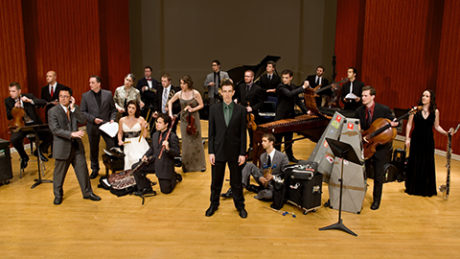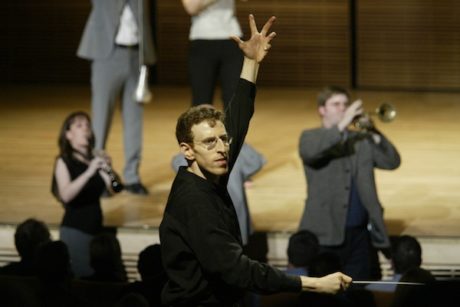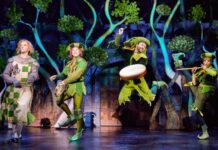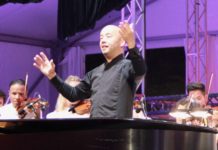The East Coast concert premiere of The Hunger begins with a harsh, discordant note, immediately conveying that this will be a performance about pain. The short opera, from modern Irish composer Donnacha Dennehy, explores the trauma and suffering of his homeland’s nineteenth-century Great Famine, as well as its root causes and its ongoing relevance to our contemporary world. As part of The Kennedy Center’s celebration of the last one hundred years of Irish arts and culture, the opera’s foray into this complicated subject matter is innovative and interesting.

Widespread tragedies such as the mass starvation that afflicted Ireland in the mid-1800s can be understood both through the individual stories of those who lived through them and through scholarly analysis of the dynamics that brought them to be. The Hunger approaches the Great Famine from both directions at once. Its libretto is sung by two characters, one woman and one man, each of whom personifies and personalizes the massive suffering of the time. The woman is meant to be Asenath Nicholson, an American author who traveled to Ireland during two years of the famine, who spoke and lived with the impoverished, and who documented her experiences in an extensive written account.
Sung by accomplished soprano Katherine Manley, her lines were distilled from that account and emphasize the human agony that Nicholson witnessed and her inability to forget it.
The anonymous male character, voiced in Gaelic by famed sean nós (a highly stylized form of traditional Irish singing) soloist Iarla Lionáird, complemented Nicholson’s lyrics with soulful verses of his own misery and helplessness. The instrumental music that accompanied both of them, brought to life by the New York-based ensemble Alarm Will Sound, ranged over the course of the performance from up-tempo and jarring to slow and mournful, with many detours along the way to places and paces in between.
But the soloists who stood at the forefront of the stage and the orchestra that occupied its center were only two of the three classes of performers on display in The Hunger. The third participated via five large flat-screen televisions situated, just above eye level, in a semi-circle above and behind the orchestra, facing the audience. Each television was dedicated to a different scholar with views on the Great Famine, including one who wrote a biography of Nicholson, Maureen Murphy, and the more recognizable commentators Noam Chomsky and Paul Krugman.
Throughout the performance, while the orchestra played, the television screens snapped to life to deliver video clips of these scholars opining on the famine, on the political and economic policies that contributed to it, and on lessons to be drawn therefrom. It was a bold experiment—merging the technology and “talking head” format of modern media with the classically styled presentation of opera and sean nós, and it had the potential for innovative greatness. That it did not fulfill that potential largely resulted from its inability to resolve the tensions between its contradictory elements. As a consequence, the performance delivered some memorable moments but fine-tuning was needed for all the elements to work together.

The Alarm Will Sound band, an enthusiastic 20-member troupe well accustomed to tackling difficult modern works, was certainly up to the challenge and delivered a confident performance throughout the ever-changing score.
As for the singers, Manley struggled with the lower end of her vocal range but shined with power and precision as she moved into the higher notes, whereas Lionáird is consistently solid if slightly muted throughout. Both emote well with the material—Manley’s laments conveyed the poignancy of the subject matter without venturing into the maudlin, while Lionáird’s affecting, soulful delivery conveyed the timelessness of the tragedies to which he was giving voice. The problem for both, however, is that they frequently struggled to be heard above the instrumental music.
From the standpoint of pure comprehension, the production would benefit from sub- or supertitles, as Manley’s English lyrics were frequently no easier to discern than Lionáird’s Gaelic verse, and the audience should not be tempted to read the libretto from the program in the dim lights of the concert theater. And from a purely artistic standpoint, the production would have benefited from more complementary sound balance between the orchestra and the soloists.
It should be noted that, at two junctures in the performance, the live vocalists literally took their seats while recordings of Gaelic singers played, but these recorded vocals suffered from the same issues. The intent was likely to make the audience further feel the pull of the past into the present, but with that role already being played by the live performers and with the transitions to and from the recordings being somewhat abrupt, it risked being perceived as a gratuitous effort to introduce yet another form of media to the stage.
The implementation of the academic commentary from the five recorded scholars, however, created the greatest problems for The Hunger for me. Dennehy should be applauded for his experimental approach with the format, as few composers would have the courage to let these decidedly non-musical voices collide with their orchestral score. Part of the issue stemmed from the recorded video commentary itself, all of which came from interviews by the Dublin-based director Tom Creed, who also collaborated with Dennehy on other aspects of the production.
While all five featured academics are highly respected in their fields, the majority of the commentary consisted of brief, high-level comments on the magnitude of the tragedy, the political and economic policies that fueled it, and whether similar dynamics exist or could manifest themselves today.
The clips often felt disjointed and out of context; between sorrowful lamentations we heard vague platitudes about inequality and the failure of the free market system, which hinted at deeper insights into the culpability of the political elite in human suffering without quite getting there.
As a more practical matter, the implementation of the academic commentary on video screens also suffered simply because the commentary was frequently difficult to discern. The academic remarks played simultaneously with the orchestra, creating not a synergy but rather a competition from which both suffered. I was left with the impression of a professor (sometimes five of them) attempting to talk over a piece of music and a piece of music attempting to play over a professor, and in the process, it became difficult to focus on or to comprehend the sounds of either.
Perhaps this discord, like the opening notes of the opera itself, were intended to convey the confusion and dystopia of famine-stricken Ireland, but the dominant effect was to prevent the meaning of any of the voices or music from coming through. here is also a great irony, presumably unintended, whenever the economic and political scholars, while critiquing the cold-hearted policies of their predecessors that elevated academic theory above the human experience, delivered their own esoteric remarks on top of and to the detriment of a beautiful piece of music being performed live on stage.
At one point, towards the end of the piece, all five television screens activated at once, playing video statements from the five academics simultaneously and bringing them as much into competition with each other as with the music. While this was designed to be, and in some ways is, a powerful development, it primarily served to underscore the fundamental problem with the composition: Nothing could truly be heard or understood amidst the fray of its constantly competing elements.

In the program notes, Dennehy references a plan for his collaborator Creed to direct “a stage version” of the piece. One wonders how exactly that will differ from last night’s Kennedy Center performance, as it is unclear how further staging would operate or would benefit the production. Aside from the orchestra itself, there are nine participants in the opera: five academics who appear in pre-recorded videos, two unseen Irish singers who are heard in pre-recorded audio, and two soloists who take turns singing short monologues in different languages, rarely interacting musically and never interacting as characters. Hopefully, Dennehy and Creed have something further innovative up their sleeves that will surprise and inspire.
For this experiment should not be merely academic; as England and Ireland experienced historic peaks of inequality during the mid-1800s, so too does America today. The political and economic choices of our leaders have meaningful consequences, as they did during the Great Famine.
The Hunger could have served as warning: our leaders may lead us to suffering in the name of the free market, in the name of political calculus, and we should be cautious and wary of such leadership. Instead, its competing elements lent themselves to a chaotic cacophony, an auditory overload that felt less like a warning and more like a cry from a world without hope.
Running Time: 75 minutes with no intermission.
The Hunger played for one night only on June 1, 2016, at The Kennedy Center’s Terrace Theater – 2700 F Street NW, in Washington, DC. The Hunger is part of the Kennedy Center’s Ireland 100 Festival, which plays through June 5, 2016. For future performances and information at The Kennedy Center, check their calendar of events.
Note: This review was written in collaboration with Dana Wagner.





